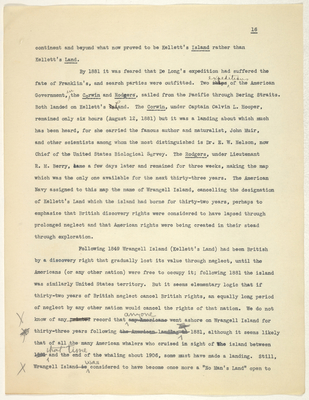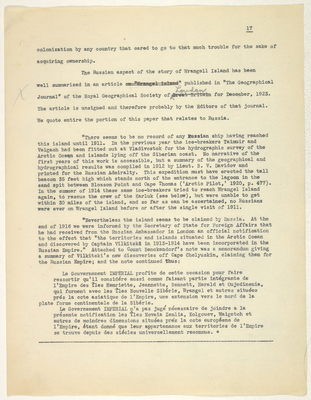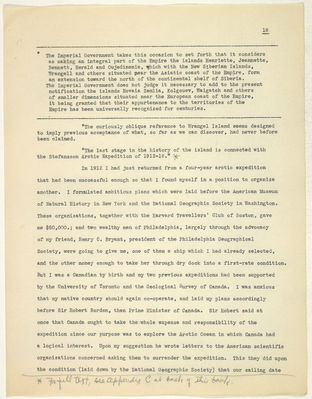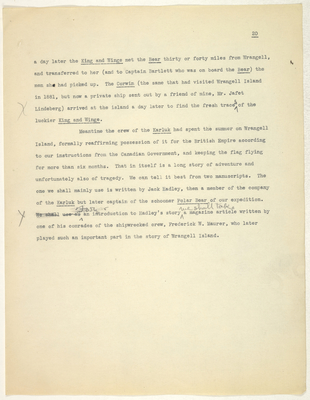Pages
stefansson-wrangel-09-26-001-021
16
continent and beyond what now proved to be Kellett's Island rather than Kellett's Land.
By 1881 it was feared that De Long's expedition had suffered the fate of Franklin's, and search parties were outfitted. Two ships, expiditions of the American Government, in the Corwin and Rodgers, sailed from the Pacific through Bering Straits. Both landed on Kellett's island Land. The Corwin, under Captain Calvin L. Hooper, remained only six hours (August 12, 1881) but it was a landing about which much has been heard, for she carried the famous author and naturalist, John Muir, and other scientists among whom the most distinguished is Dr. E. W. Nelson, now Chief of the United States Biological Survey. The Rodgers, under Lieutenant R. M. Berry, came a few days later and remained for three weeks, making the map which was the only one available for the next thirty-three years. The American Navy assigned to this map the name of Wrangell Island, cancelling the designation of Kellett's Land which the island had borne for thirty-two years, perhaps to emphasize that British discovery rights were considered to have lapsed through prolonged neglect and that American rights were being created in their stead through exploration.
Following 1849 Wrangell Island (Kellett's Land) had been British by a discovery right that gradually lost its value through neglect, until the Americans (or any other nation) were free to occupy it; following 1881 the island was similarly United States territory. But it seems elementary logic that if thirty-two years of British neglect cancel British rights, an equally long period of neglect by any other nation would cancel the rights of that nation. We do not know of any printedrecord that anyone say Americans went ashore on Wrangell Island for thirty-three years following the American landing in 1881, although it seems likely that of all the many American whalers who cruised in sight of the island between 1881 that timeand the end of the whaling about 1906, some must have made a landing. Still, Wrangell Island is was considered to have become once more a "No Man's Land" open to
stefansson-wrangel-09-26-001-022
17
colonization by any country that cared to go to that much trouble for the sake of acquiring ownership.
The Russian aspect of the story of Wrangell Island has been well summarized in an article on "Wrangel Island"published in "The Geographical Journal" of the Royal Geographical Society of Great Britain London for December, 1923. The article is unsigned and therefore probably by the Editors of that journal. We quote entire the portion of this paper that relates to Russia.
“There seems to be no record of any Russian ship having reached this island until 1911. In the previous year the ice-breakers Taimuir and Vaigach had been fitted out at Vladivostok for the hydrographic survey of the Arctic Ocean and islands lying off the Siberian coast. No narrative of the first years of this work is accessible, but a summary of the geographical and hydrographical results was compiled in 1912 by Lieut. B. V. Davidov and printed for the Russian Admiralty. This expedition must have erected the tall beacon 35 feet high which stands north of the entrance to the lagoon in the sand spit between Blossom Point and Cape Thomas ('Arctic Pilot,' 1920, p. 477). In the summer of 1914 these same ice-breakers tried to reach Wrangel Island again, to rescue the crew of the Karluk (see below), but were unable to get within 30 miles of the island, and so far as can be ascertained, no Russians were ever on Wrangel Island before or after the single visit of 1911.
"Nevertheless the island seems to be claimed by Russia. At the end of 1916 we were informed by the Secretary of State for Foreign Affairs that he had received from the Russian Ambassador in London an official notification to the effect that "the territories and islands situated in the Arctic Ocean and discovered by Captain Vilkitski in 1913-1914 have been incorporated in the Russian Empire." Attached to Count Benckendorf's note was a memorandum giving a summary of Vilkitski's new discoveries off Cape Chelyuskin, claiming them for the Russian Empire; and the note continued thus:
Le Gouvernement IMPERIAL profite de cette occasion pour faire ressortir qu'il considdre aussi comme faisant partie intdgrante de l'Empire des iles Henriette, Jeannette, Bennett, Herald et Gujedinenia, qui forment avec les iles Nouvelle Sibdrie, Wrangel et autres situees pres la cote asiatique de l'Empire, une extension vers le nord de la plate forme continentale de la Sibdrie.
Le Governement IMPERIAL n'a pas juge necessaire de joindre a la presente notification les iles Novaia Zemlia, Kolgouev, Waigatch et autres de moindres dimensions situees pres la cote europdene de l'Empire, etant donne que leur appartenance aux territories de l'Empire se trouve depuis des siecles universellement reconnue. *
stefansson-wrangel-09-26-001-023
18
*The Imperial Government takes this occasion to set forth that it considers as making an integral part of the Empire the islands Henriette, Jeannette, Bennett, Herald and Oujedinenia, which with the New Siberian Islands, Wrangell and others situated near the Asiatic coast of the Empire, form an extension toward the north of the continental shelf of Siberia. The Imperial Government does not judge it necessary to add to the present notification the islands Novaia Zemlia, Kolgouev, Waigatch and others of smaller dimensions situated near the European coast of the Empire, it being granted that their appurtenance to the territories of the Empire has been universally recognized for centuries.
”The curiously oblique reference to Wrangel Island seems designed to imply previous acceptance of what, so far as we can discover, had never before been claimed.
"The last stage in the history of the island is connected with the Stefansson Arctic Expedition of 1913-18.” *
In 1912 I had just returned from a four-year arctic expedition that had been successful enough so that I found myself in a position to organize another. I formulated ambitious plans which were laid before the American Museum of Natural History in New York and the National Geographic Society in Washington. These organizations, together with the Harvard Travellers' Club of Boston, gave me $50,000.; and two wealthy men of Philadelphia, largely through the advocacy of my friend, Henry C. Bryant, president of the Philadelphia Geographical Society, were going to give me, one of them a ship which I had already selected, and the other money enough to take her through dry dock into a first-rate condition. But I was a Canadian by birth and my two previous expeditions had been supported by the University of Toronto and the Geological Survey of Canada. I was anxious that my native country should again co-operate, and laid my plans accordingly before Sir Robert Borden, then Prime Minister of Canada. Sir Robert said at once that Canada ought to take the whole expense and responsibility of the expedition since our purpose was to explore the Arctic Ocean in which Canada had a logical interest. Upon my suggestion he wrote letters to the American scientific organizations concerned asking them to surrender the expedition. This they did upon the condition (laid down by the National Geographic Society) that our sailing date *For full text, see appendix C at back of this book.
stefansson-wrangel-09-26-001-024
19
must not be delayed beyond 1913 and that the scientific program of the expedition should remain substantially as already outlined by me.
When we sailed north in the spring of 1913 one paragraph of our orders from the Canadian Government instructed us to plant the British flag on any new or partly unknown lands which the expedition should touch. This brought us into direct relation with Wrangell Island, a land originally discovered by a British naval expedition.
However, we did not have the intention to sail for Wrangell Island. Indeed, our plan was to go in a different direction, but Fate took a hand. The ice hemmed in one of our ships, the Karluk, late in the summer of 1913, and carried her a prisoner west along the north coast of Alaska and then in the direction of Wrangell Island, near which she sank in January, 1914, the men landing early in March. Our expedition at this stage had three ships. I was with the other two at Collinson Foint, in northeastern Alaska, ignorant for more than a year of the fate of the Karluk, which was under the charge of her sailing master, Captain Robert A. Bartlett, a native of Newfoundland and in Canadian employ although then recently become a naturalized citizen of the United States. After making a landing on Wrangell, Captain Bartlett instructed his men to remain there, while he, with one companion, crossed the hundred mile ice bridge to the European and native settlements of Siberia and then proceeded seven hundred miles across country to Emma Harbor to send out a wireless call for help.
Many ships responded. The Russian Government instructed their ice-breakers, Taimyr and Vaigatch, to proceed to Wrangell Island. They had not been able to get within sight of the island, however, when they received a wireless telling that the Great War had started and that they must return south. The United States revenue cutter Bear made an attempt but also failed. Several private ships tried. The successful one was the King and Winge under her owner, Olaf Swenson, who had been induced to make the attempt by Burt M. McConnell, a former member of our expedition. Her Captain, A.T.P. Jochimsen, was used to the sort of ice he had to contend with and wormed his way up to the island. Southward bound
stefansson-wrangel-09-26-001-025
20
a day later the King and Winge met the Bear thirty or forty miles from Wrangell, and transferred to her (and to Captain Bartlett who was on board the Bear) the men she had picked up. The Corwin (the same that had visited Wrangell Island in 1881, but now a private ship sent out by a friend of mine, Mr. Jafet Lindeberg) arrived at the island a day later to find the fresh traces of the luckier King and Winge.
Meantime the crew of the Karluk had spent the summer on Wrangell Island, formally reaffirming possession of it for the British Empire according to our instructions from the Canadian Government, and keeping the flag flying for more than six months. That in itself is a long story of adventure and unfortunately also of tragedy. We can tell it best from two manuscripts. The one we shall mainly use is written by Jack Hadley, then a member of the company of the Karluk but later captain of the schooner Polar Bear of our expedition. We shall use as [For] an introduction to Hadley's story we shall take a magazine article written by one of his comrades of the shipwrecked crew, Frederick W. Maurer, who later played such an important part in the story of Wrangell Island.




